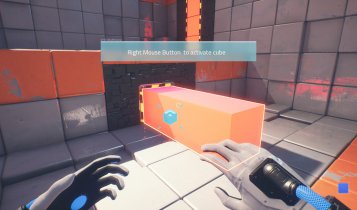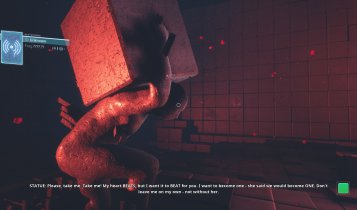Solve complex puzzles in a gorgeous environment — hopefully without your brain melting…
It just so happens that I played through the original Q.U.B.E. a few weeks ago (well, the director’s cut, anyway) and found it to be enjoyable, although very hard at times. The simple process of moving blocks in and out of walls to create paths for yourself and other objects lead to some utterly devious puzzles thanks to the various block types being used in creative ways. The plot was somewhat vague and some of the physics-based puzzles were more irritating than challenging, but on the whole it was a fun experience that I’d let sit in my backlog for far too long. And now, here comes Q.U.B.E. 2 to build on the foundations of the original.

We begin as Milly, staggering through a sandstorm in some sort of desert towards an outpost where we assume she will be safe. Before she arrives, though, she collapses and blacks out, only to wake wearing a mysterious white suit in a hallway with cubes all over the walls. Milly is contacted by a woman named Emma who informs her that she needs to find her way to a beacon inside the structure to be rescued. Over the course of the game, we discover that things aren’t quite as they appear — and how the events of the first game tie into where Milly is and what her true objectives are. The plot seems a little convoluted at times and a few elements seem to be glossed over, but by the end things slot into place with a really interesting way of handling multiple endings.
Q.U.B.E. 2 keeps many the original’s elements, but allows players more freedom to experiment. Over the course of the game, players gain the ability to use different coloured blocks, each with their own properties. Red blocks can be extended outwards, blue blocks act as jump pads, whilst green blocks let you create additional blocks in the world. The yellow and purple blocks of the previous game are gone, but that’s not the only change. From the outset, players can place blocks anywhere they see a white block on the walls, floor and ceiling in a similar way to the final sections of the previous game. Whilst playing, I felt more like I was genuinely solving the puzzles through my own cunning block placement rather than simply spotting the pattern the developers had laid out for me. The sense of satisfaction when you solve a large puzzle with several moving parts is fantastic, as it feels like all your own work.
As you travel through the game world and gain the ability to use more types of blocks, Q.U.B.E. 2 has a great system to teach you how to use them — through environmental cues rather than outright telling you. Large, coloured objects on the wall make it clear what can be interacted with, whilst the white squares for you to place blocks on are clear and obvious, even when the actual solution initially isn’t. There’s great variety in the puzzles, thanks to the way blocks interact with the world. They can be covered in oil to make them slippery or ignited to open certain pathways, whilst other doors can be unlocked by having a block smash into them at high speed. This variety kept the game fresh throughout, and even when a puzzle seems very challenging, there were often ways to attempt other ones before coming back later thanks to a hub setup for each puzzle area. This was rare, however, as the puzzles are incredibly well balanced, walking that fine line between being not too challenging and being hard enough to make you feel smart when you solve them.

Having said that, I did come across one puzzle during the late game that threw me, as it used a mechanic that either hadn’t been taught or hadn’t come up often enough to be a memorable one. Suffice to say, your momentum can be maintained by jumping once launched through the air. I didn’t know this, meaning that one wide gap proved to be a problem for me. Once I figured that out through experimentation, I managed to progress. This was the only real stumbling block during my playthrough. The other puzzles let me progress once I’d spent enough time walking through each room, determining where I needed to get to and where blocks could be placed. It’s a really enjoyable process that can lead to some genuinely satisfying chains of events which you will have set into motion.
In terms of the visuals, it seems that Toxic Games has taken the opportunity to experiment with environmental design. Whilst the previous instalment was very sterile for the most part, Q.U.B.E. 2 is much more varied. Early areas are somewhat dingy, but open up into beautiful outdoor areas before heading back into those more sterile environments, followed by almost Aztec-style areas. There’s a lot of creativity on show here and whilst I couldn’t quite figure out how the different areas tied together in terms of the plot, it was nice to see fresh environments from time to time. The game looks very good on the whole and ran surprisingly well on my laptop, with a consistent ninety frames per second on maximum settings. The voice work is very good once again, as is the sound design — everything sounds solid, and when something in the environment changes, the effects make it clear what sort of thing is happening, even if it’s out of sight.

Q.U.B.E. 2 is an excellent example of a sequel. The developers saw what did and didn’t work in the original game and built on that knowledge to create an excellent five-hour experience. If you played the original and enjoyed it, there’s no way you should ignore this. If you haven’t played the original, then this is still an excellent first-person puzzle game (although you’ll get more out of it if you have played the first) and deserving of your attention. Be prepared to test that brain power, though!